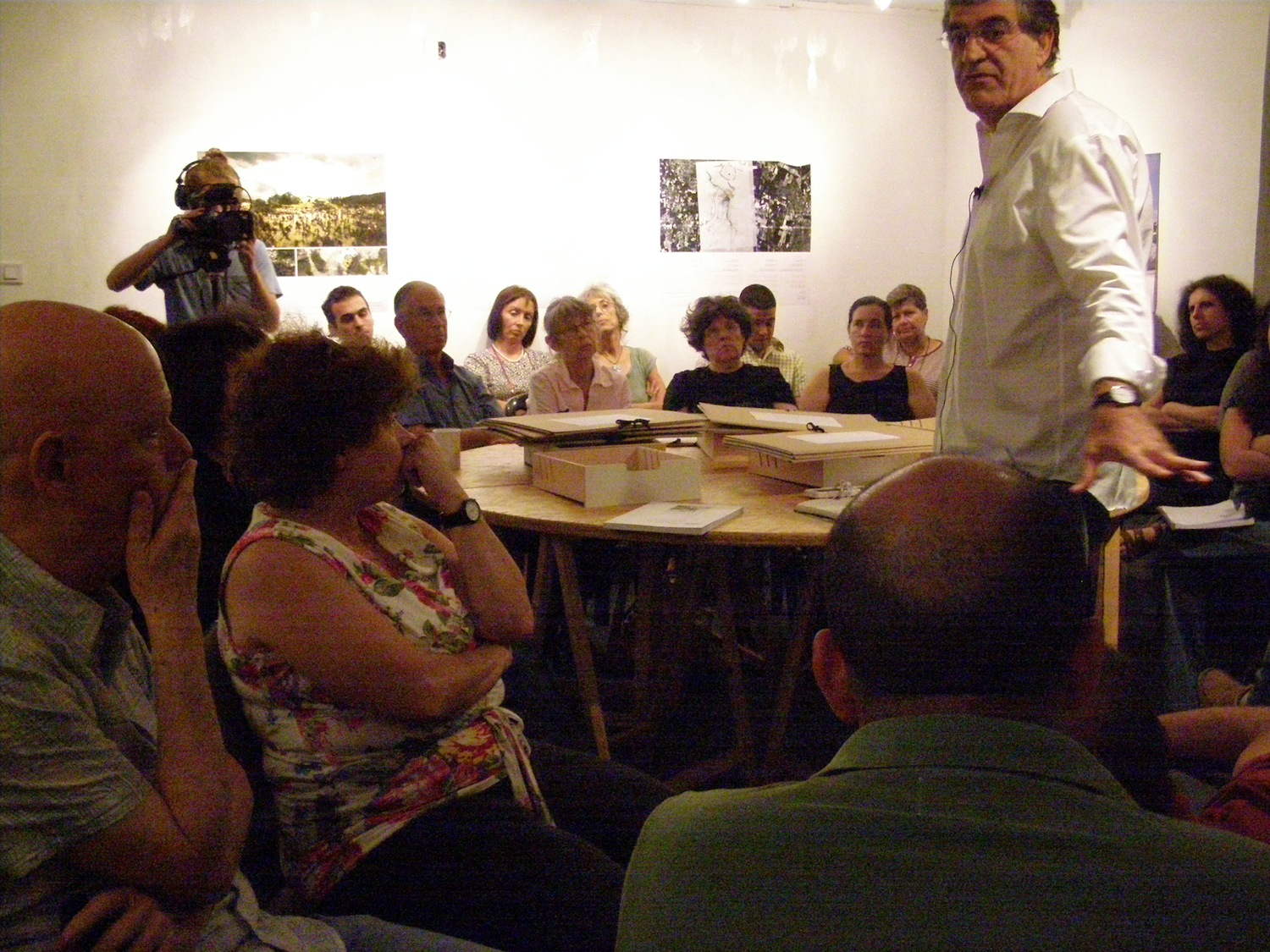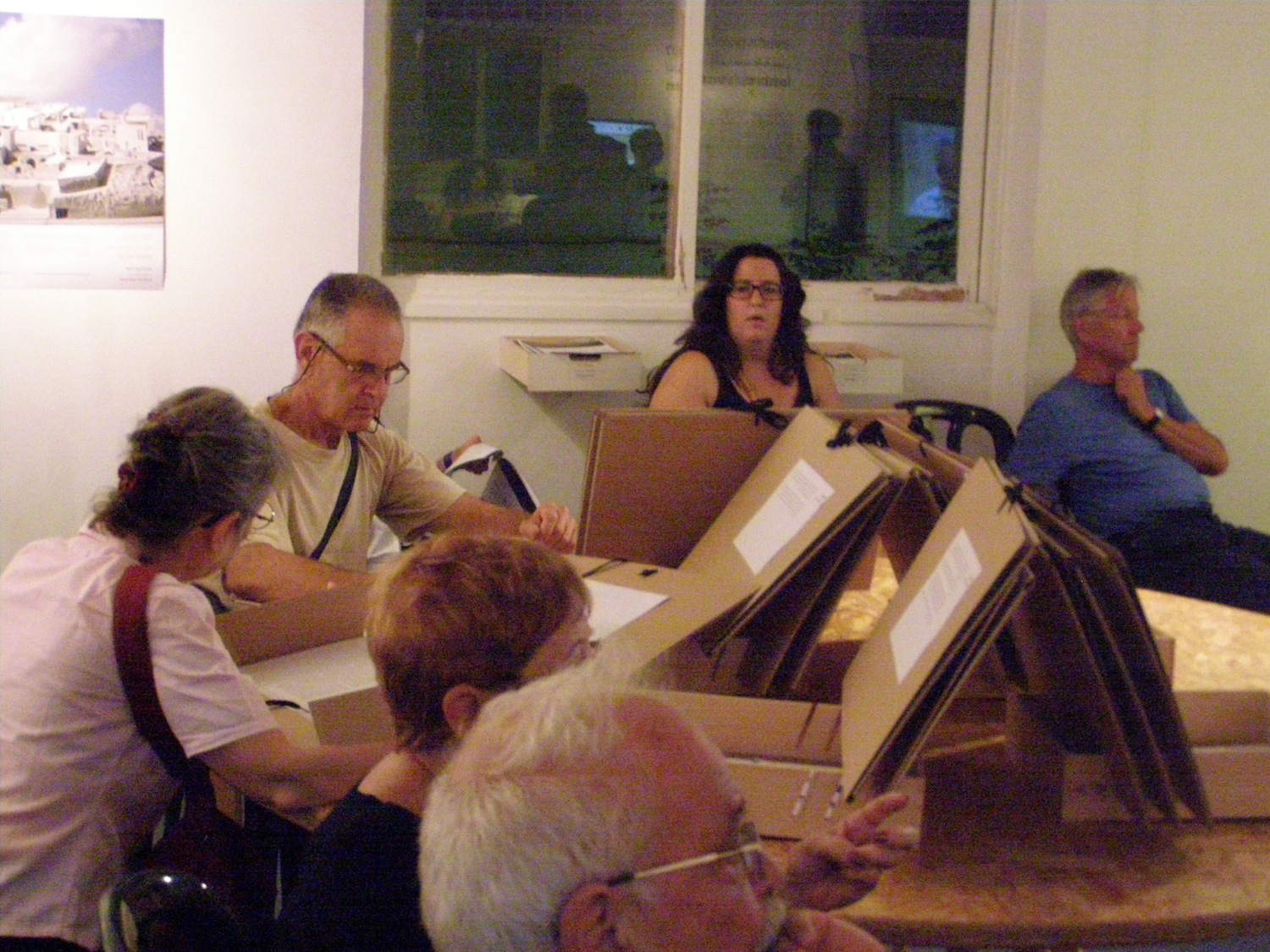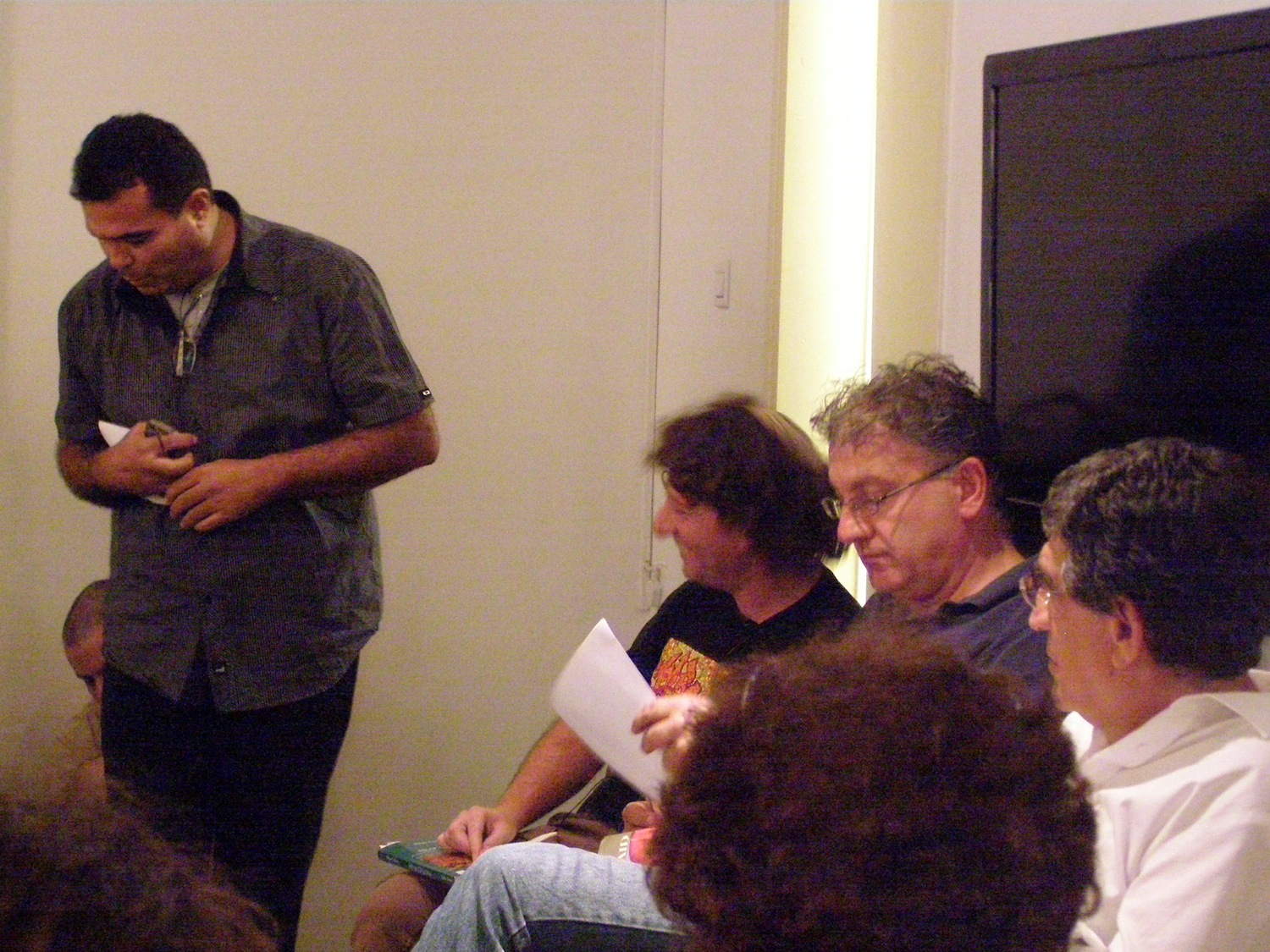Almost a protocol of what was said at the opening of the exhibit, “Toward the return of Palestinian refugees,” at Zochrot.
Aviv Gross Alon: This exhibit is based on computer files Zochrot began publishing in May, 2011, on its web site. It’s based on a practical project for the return of Palestinian refugees that Zochrot has been conducting for more than three years. The exhibit presents various plans dealing with return. The drawers contain texts related to the return. A Power Point presentation describes Zochrot’s view of the nakba and the return. You can also comment on the projects and write responses to Zochrot.
Umar al-Ghubari: Thanks to Aviv for all her (his?) work on the exhibit. It’s part of a cultural activity we’re promoting dealing with the return of Palestinian refugees. Tonight’s speakers include Prof. Yehuda Shenhav, a sociologist, Dr. Ra’if Zureik, a lecturer on the Philosophy of Law, and Eliaz Cohen, a poet and member of Kibbutz Kfar Etzion. I’m Umar; I work for Zochrot and coordinate the return project and Zochrot’s tours. Those tours are intended to teach the country’s history and geography in the context of what happened here in 1948. But since Zochrot began dealing with the return of the refugees, these destroyed localities began to be conceived as potential sites for a future return. Instead of continuing to argue about the right of return, Zochrot decided to think about implementing the return. We began planning the return to the village of Miska together with members of the Shvita family who’d been uprooted from the village. When we began planning the return we faced dilemmas such as how Zochrot, as an Israeli organization, can plan the return? So we joined with Palestinians, like the Badil organization from Bethlehem, and ‘A’adun, from Syria and Lebanon. The plans shown here address the return to specific villages, and don’t deal with the country as a whole. That’s what we want to do this evening, with the help of our speakers.
Yehuda Shenhav: Wants to talk about three things. Why is it necessary to return to ’48, and why Zochrot’s work is important. Second, what conception of sovereignty makes return possible? Third, the space and time of return. I speak as an Israeli Jew, not as a Palestinian.
Return is not possible in two states for two peoples. The Israeli sovereign founded itself on preventing return. The Israeli sovereign speaks the language of legality and can’t admit to the ethnic cleansing of 1948. That’s why anyone who wants two states for two peoples requires we forget what happened in ’48 and is part of the most conservative Israeli approach. That’s why it’s important to hear what Eliaz Cohen has to say as a settler in the territories from 1967. Israel must remove the skeleton of 48 from the closet. The sovereign doesn’t tell us that because he rules by using the language of 48, the language of law. We saw in the recent social protest a demonstration of Israeli solidarity by those who lost power in 77. Sovereignty exists over matter, over territory, over life – the population – and over the spirit, identity. Lieberman is right, the subject is 48. The monopoly on identity and on territory results from the Peace of Westphalia in which the princes divided territories among themselves. The democratic Jewish state within the 67 borders will always be in a state of emergency but will make sure to conceal the fact. The Westphalian system is based on concealing the internal conflict; the only conflict is recognizes is external. Other, non-Westphalian, sovereignty must belong jointly to all subjects in the territory. Not a divided territory. It’s important that there not be a one-to-one correspondence between territory and population. How do we think about return? We must think differently about time and space. I think return is possible, not only one recognized symbolically. But return can’t reflect a narrative of “from destruction to redemption.” Return must exist constantly and as a myth. Settlements don’t have to be evacuated in the context of return. It’s immoral to expel a third generation that has been born there. The damage done to the Palestinians by the settlements is minor compared to what was done, for example, by Upper Nazareth. Why must one million residents of the Galilee to forced to accept a Jewish identity? Did the nakba occur only in ’48? Isn’t ‘Araqib also nakba? Isn’t the nakba is a continuing present? That’s why questions of time and space blend together. That’s why return must be thought of in political, not mythic, terms.
Umar: Return will take many different forms.
Eliaz Cohen: Liberation from the 67 paradigm, as Yehuda calls it in his book, can help swallow the bone in the throat – allowing Jews to remain everywhere in the country. There’s a doubly significant date next week - the 20th of September is the date that people returned to Kfar Etzion. It’s a locality which in fact implemented the right of return. This summer something important happened in the country, a great awakening and call for social justice. The desire for liberty is struggling to prevail in all the countries of the region, and may overcome Jewish and Islamic religious fundamentalism. Great possibilities exist for cooperation between Judaism and Islam, but the connection with Christianity led us elsewhere. In 48 the residents of Kfar Etzion were defeated and slaughtered by Palestinians whose cries referred to Deir Yassin. The remembrances of the locality’s orphans and their desire to return convinced Levi Eshkol in 1967 to allow the reestablishment of Kfar Etzion. The return must not involve expulsion of people from their homes. The wound of 48 must be healed – first it must be recognized, the wound both sides suffered. Zochrot’s work is holy because it treats what is denied, heals, tempers. The work of healing is common to both peoples. We must stop counting both peoples. And we must stop dealing with weapons of war.
Umar: The discourse of return is also lacking among many Palestinians. We had an interesting meeting in Jordan with Palestinians from Miska who were surprised, and only later in the discussion did they ask practical questions about return. There aren’t many initiatives for actual return. Ra’if Zureik asked at a conference a while ago “where do you want to return to, because the place is no longer there?” The question raised a storm.
Ra’if Zureik: It’s possible to ask, provocatively, “I don’t understand what the problem is; we’ll get buses and return the refugees.” The question is how to enable the return. What mentality is needed for return to occur? Must we wait until the Jews change their conception? Time moves forward, and return isn’t possible. Palestine is important as the foundation of Palestinian identity. Thinking about return as moving forward can liberate thinking about return. No historical compromise is possible without recognizing 48. The place has changed after more than six decades; it’s no longer the same place and that’s why it can’t be returned to. In the long run there’s no alternative to a single space, but in the short term it seems there must be two separate spaces. 48 is the root of the problem and it must be confronted to solve the conflict, but perhaps the solution doesn’t require going back to 48 right away. The problem of the Left is that it formulates the basic problem as 67, which doesn’t permit a solution because the occupation of 48 remains invisible. The political solution doesn’t have to return to 48, other than in the distant future. I propose distinguishing between homeland and state. Discussion must be flexible and permit both. Palestinians speak a great deal about justice and in Lebanon, for example, justifiably demand an end to the suffereing.
Dan Goldenblatt asks: In the two state solution, only the settlers will pay the price, not Israelis in general. That’s unfair.
Question: The settlements harm the Palestinians, so how can they be left in place?
Question: Would the solution be different if there were no settlements?
Question: Can settlements continue to be built?
Question: If not two states, then what? Do Palestinians also have the right to return to places from which they were expelled, like Kfar Etzion did?
Yehuda: The question is whether there are settlers who are democratic as opposed to settlers who aren’t democratic. Beilin proposes evacuating settlements so money will be available for development towns, but I think he misses the point. Return must be in exchange for the settlements remaining. I don’t think Zionism was illegitimate from its inception. It was justified demanding for itself the myth of return. The implementation of Zionism was unjust.
Eliaz: My slogan is one homeland for two peoples. Two peoples share this homeland and are connected to it. Two states can be established based on the partition plan of UN Resolution 181, with open borders and open localities and an open economy. Two grasp a tallit and the midrash responds that it should be divided between them. I propose dividing in the sense of “sharing;” that is, that both sides have an equal right to the country. We members of the Jerusalem Movement have had dozens of meetings in Jewish and Arab localities on the West Bank.
Umar: Thank you very much.

15.9.2011 / ערב פתיחה ודיון בתערוכה לקראת שיבת פליטים פלסטינים / Exhibition opening: Towards return of Palestinian refugees

15.9.2011 / ערב פתיחה ודיון בתערוכה לקראת שיבת פליטים פלסטינים / Exhibition opening: Towards return of Palestinian refugees

15.9.2011 / ערב פתיחה ודיון בתערוכה לקראת שיבת פליטים פלסטינים / Exhibition opening: Towards return of Palestinian refugees


